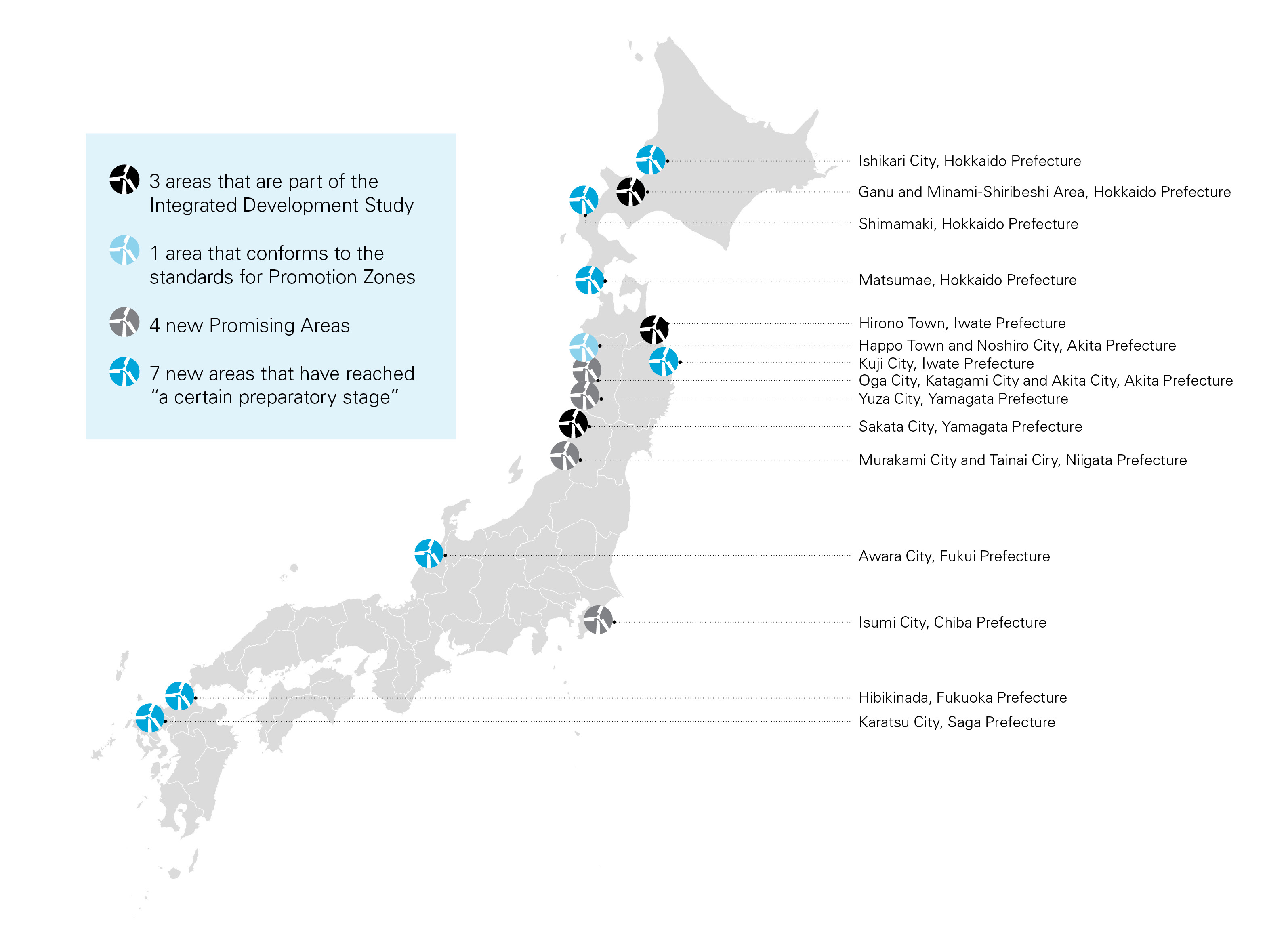
Change is in the air – Japan introduces changes for a more efficient OSW site selection process
7 min read
On July 30, 2021, the Agency for Natural Resources and Energy (ANRE) of the Ministry of Economy, Trade and Industry (METI) together with the Port Authority of the Ministry of Land, Infrastructure, Transport and Tourism (MLIT) made a number of important announcements regarding offshore wind regulation in Japan. They announced the three sea areas that will take part in what is being called the Study for Offshore Wind Project Integrated Regional Development (the Integrated Development Study).1 They also released new Guidelines for Designation of Offshore Renewable Energy Power Facility Promotion Zones (the New Guidelines),2 which set out the specific criteria and procedures for the designation of Promotion Zones as stipulated in the Act Concerning Promotion of Use of Marine Area for Development of Offshore Renewable Energy Generation Facilities (the OSW Act).3 The purpose of the New Guidelines is to establish the management policies for the government to secure the grid capacity in advance of the auction process, and they are expected to help facilitate the commercialization of offshore wind projects at an earlier stage of development.
These reforms are part of the Japanese government's plan to accelerate the formation of offshore wind projects in order to reduce Japan's greenhouse gas emissions to net-zero by 2050. The government's ambitious targets were announced in December 2020 by Prime Minister Suga and accompanied by a METI white paper titled the Green Growth Strategy Through Achieving Carbon Neutrality in 20504 and a strategy document titled Vision for Offshore Wind Power Industry (1st) (the OSW Vision)5 prepared in cooperation with industry participants. In its discussion of energy transition, the OSW Vision identifies specific targets for offshore wind development including (i) designating enough Promotion Zones to generate approximately 1GW of offshore wind power per year for the next 10 years, and (ii) awarding 10GW of capacity by 2030 and 30-45GW by 2040.
Streamlining the Site Selection Process
In order to achieve the targets for increased renewable energy production from offshore wind, it is widely acknowledged that the government must streamline the site selection process. This not only means accelerating the identification of new Promotion Zones, but also eliminating inefficiencies for governmental and commercial actors. As a part of its analysis, the OSW Vision addresses areas identified by developers and industry participants where the OSW Act should be improved. Two of its key recommendations includes (i) bringing forward the timing for the government's wind and geological surveys and making the survey data available to developers at an earlier stage in the process, and (ii) introducing a mechanism for the government to temporarily secure grid capacity for a Promotion Zone instead of utilizing the grid capacity secured by incumbent developers.
The areas selected for the Integrated Development Study are (1) Ganu and Minami-Shiribeshi districts, Hokkaido Prefecture (fixed bottom), (2) Sakata City, Yamagata Prefecture (fixed bottom), and (3) Hirono Town, Iwate Prefecture (floating), and were determined by a panel of third-party experts following a call for recommendations from prefectures6 and the private sector7 issued on May 10, 2021. Through the initiative, METI and MLIT propose to establish a "Centralised Model" (borrowing from certain European precedents) that will integrate the efforts of national and local governments from the initial stages of offshore wind project site evaluation. By doing so, ANRE and the Port Authority expect to conduct wind, seabed, geological and other relevant studies in a more efficient and timely manner with results provided to prefectures and developers concurrently, thereby reducing certain inefficiencies identified by industry participants.
The integration of the interests of developers demonstrates the importance of commercial participation in offshore wind development and the complexity of the process. The results to be compiled from the Integrated Development Study will include: (i) wind surveys, (ii) seabed, meteorological and oceanographic surveys, (iii) surveys of items common to developers in initial stage environmental impact assessments, and (iv) fishery surveys.
Grid Connection Requirements
Streamlining the site survey process is only part of the solution discussed in the OSW Vision. Another important component is to eliminate inefficiencies identified in the grid connection requirements for developers. It has been pointed out that some regions of Japan have seen significant inefficiencies and duplication where multiple developers have had to carry out early-stage basic surveys to secure access to power grids. As development risk is high, it has been suggested that the Japanese government should take the lead in early stage development to stimulate commercial participation and competition. The New Guidelines address the recommendations of the OSW Vision by, among other things, introducing amendments to the grid connection process to eliminate the duplication of efforts by developers by allowing the Japanese government to secure grid connection on a provisional basis for the proposed offshore wind project auction site. The connection will then be transferred to the winning developer upon the conclusion of the auction process.
The implications of the grid connection process established in the New Guidelines also serve to accelerate the Promotion Zone selection process. The fourth condition for becoming a Promotion Zone under the OSW Act is that the grid connection between the power generating facility and the power lines maintained and operated by the electric power supplier must be properly secured. In areas where there is an incumbent developer with an existing grid connection this requirement is already satisfied, but otherwise this step can be costly and time consuming if new-entry developers are required to complete it. Under the New Guidelines, if there is no such incumbent developer with existing secured grid capacity, the government securing provisional capacity would satisfy the Promotion Zone condition without requiring new-entry developers to assume the risk.
The New Guidelines also provide that the government would undertake the process to secure the grid capacity "only" if the purpose of doing so is to secure fairness and impartiality and to avoid duplication of efforts by multiple developers. This suggests to us that METI and MLIT will not be inclined to interfere with the efforts of an incumbent developer (except if it is necessary from a fairness perspective) and will respect the efforts of incumbent developers who have already secured grid connection with the regional utility company.8
Looking forward
While the New Guidelines represent progress in the development of the regulatory framework for offshore wind project development in Japan, the New Guidelines do not provide detailed rules for how and when the results of the government-led grid connection studies will be made available to developers or the precise process by which government-secured grid capacity will be transferred to auction winners. Hence, it will still be necessary to monitor how the Auction Guidelines9 and the associated regulations are further amended or supplemented to address these important details.
The changes introduced through the New Guidelines, and potentially through the Centralized Method of site evaluation, reflect the importance of developers' role in regional decision making and the priority of accelerating the site selection process. With the announcements over the summer by ANRE and the Port Authority on the 11th of August that the sites under evaluation at Happo Town and Noshiro City, Akita Prefecture10 conform to the standards for Promotion Zones, and the further announcement on the 13th of September of 4 more "Promising Areas"11 and 7 more areas that have reached "a certain preparatory stage"12 to be considered as candidates for Promotion Zones,13 we are already seeing an acceleration in site selection and can expect increased auction activity in the near future.
While there is still much work to be done in offshore wind to meet Japan's 2050 targets, these announcements demonstrate that the Japanese government is seeking to back-up its net-zero aspirations with meaningful action.
1 https://www.meti.go.jp/press/2021/07/20210730004/20210730004.html
2 https://www.enecho.meti.go.jp/category/saving_and_new/saiene/yojo_furyoku/dl/legal/guideline.pdf
3 Act No. 89 of 2018
4 https://www.meti.go.jp/english/press/2020/1225_001.html
5 (Original text) https://www.enecho.meti.go.jp/category/saving_and_new/saiene/yojo_furyoku/dl/vision/vision_first.pdf
(Provisional translation) https://www.enecho.meti.go.jp/category/saving_and_new/saiene/yojo_furyoku/dl/vision/vision_first_en.pdf
6 https://www.enecho.meti.go.jp/category/saving_and_new/saiene/yojo_furyoku/dl/announce/info_prefectures.pdf
7 https://www.enecho.meti.go.jp/category/saving_and_new/saiene/yojo_furyoku/dl/announce/info_businesses.pdf
8 https://public-comment.e-gov.go.jp/servlet/PcmFileDownload?seqNo=0000222515
9 Auction Guidelines are created specifically for each area designated as a Promotion Zone.
10 https://www.meti.go.jp/press/2021/08/20210811001/20210811001.html
11 (1) Oga City, Katagami City and Akita City, Akita Prefecture; (2) Yuza City, Yamagata Prefecture; (3) Murakami City and Tainai City, Niigata Prefecture; and (4) Isumi City, Chiba Prefecture.
12 (1) Ishikari City, Hokkaido Prefecture; (2) Shimamaki, Hokkaido Prefecture; (3) Matsumae, Hokkaido Prefecture; (4) Kuji City, Iwate Prefecture; (5) Awara City, Fukui Prefecture; (6) Hibikinada, Fukuoka Prefecture; and (7) Karatsu City, Saga Prefecture.
13 https://www.meti.go.jp/press/2021/09/20210913004/20210913004.html
White & Case means the international legal practice comprising White & Case LLP, a New York State registered limited liability partnership, White & Case LLP, a limited liability partnership incorporated under English law and all other affiliated partnerships, companies and entities.
This article is prepared for the general information of interested persons. It is not, and does not attempt to be, comprehensive in nature. Due to the general nature of its content, it should not be regarded as legal advice.
© 2021 White & Case LLP



